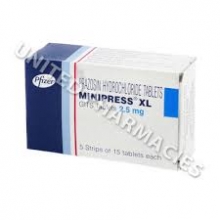Home / Categories / MINIPRESS XL-2.5MG

MINIPRESS XL-2.5MG
(15)
PRAZOSIN-2.5MG
ALPHA & BETA AGONIST
PFIZER LIMITED
Product Details
| Prazosin |
| (PRAY-zoe-sin) |
| Minipress |
| Capsules |
| 1 mg |
| Capsules |
| 2 mg |
| Capsules |
| 5 mg |
| Alti-Prazosi |
| APO-Prazo |
| Novo-Prazin |
| Nu-Prazo, Rho-Prazosin |
| Class: Antihypertensive, Antiadrenergic, peripherally acting |
 Action Selectively blocks postsynaptic alpha-1-adrenergic receptors, resulting in dilation of arterioles and veins.
Action Selectively blocks postsynaptic alpha-1-adrenergic receptors, resulting in dilation of arterioles and veins.
 Indications Treatment of hypertension.
Indications Treatment of hypertension.
 Contraindications Hypersensitivity to doxazosin, prazosin, or terazosin.
Contraindications Hypersensitivity to doxazosin, prazosin, or terazosin.
Adults: PO Initial dose: 1 mg bid to tid. Maintenance: 6 to 20 mg/day in divided doses (max, 40 mg/day).
Children: PO 0.5 to 7 mg tid has been suggested.
Alcohol: Increased risk of hypotension.
Beta-blockers: Enhanced acute orthostatic hypotensive reaction after first dose of prazosin.
Verapamil: Increased serum prazosin levels and increased sensitivity to orthostatic hypotension.
 Lab Test Interferences May cause false elevation in vanillylmandelic acid.
Lab Test Interferences May cause false elevation in vanillylmandelic acid.
CARDIOVASCULAR: Palpitations; orthostatic hypotension; hypotension; tachycardia. CNS: Depression; dizziness; nervousness; paresthesia; asthenia; drowsiness; headache. DERMATOLOGIC: Pruritus; rash; sweating; alopecia; lichen planus. EENT: Blurred vision; conjunctivitis; tinnitus; nasal congestion; epistaxis. GI: Nausea; vomiting; dry mouth; diarrhea; constipation; abdominal discomfort or pain. GU: Impotence; urinary frequency; incontinence; priapism. RESPIRATORY: Dyspnea. OTHER: Arthralgia; edema; fever.
Pregnancy: Category C. Lactation: Excreted in breast milk. Children: Safety and efficacy not established. Concomitant therapy: When adding a diuretic or other antihypertensive agent, reduce dosage to 1 to 2 mg tid and then retitrate. First-dose effect: May cause marked hypotension (especially orthostatic) and syncope at 30 min after first few doses, after reintroduction, with rapid increase (at least 2 mg) in dosing, or after addition of another antihypertensive. To avoid, initiate dosing with low dose (1 mg or up to 2 mg) and gradually increase after 2 wk. Lipids: May decrease total cholesterol levels and LDLs and increase HDLs.
| PATIENT CARE CONSIDERATIONS |
|
- Give initial dose at bedtime to avoid syncope.
- Dosage is increased slowly, usually q 2 wk, with increase given at bedtime dose.
- Give maintenance therapy in divided doses.
- Note that efficacy does not increase when dosage exceeds 20 mg/day.
- Store at room temperature in tightly-closed, light-resistant container.
- Obtain patient history, including drug history and any known allergies. Note current use of antihypertensives.
- Obtain baseline BP and pulse.
- Observe for possible retention of water and sodium.
- Monitor closely for first-dose effect. If syncope occurs, place patient in recumbent position and notify health care provider.
- Notify health care provider if patient complains of dizziness, palpitations, drowsiness, fatigue, tiredness, nausea, or headache.
|
||||
- Advise patient to take medication at same time each day.
- Warn patient about possibility of syncope or orthostasis.
- Instruct patient to report the following symptoms to health care provider: dizziness, palpitations, drowsiness, fatigue, nausea, headache.
- Caution patient to avoid sudden position changes to prevent orthostatic hypotension.
- Advise patient to avoid driving or performing other tasks requiring mental alertness for 12 to 24 hr after first dose, after dosage increase, and after resuming treatment after interruption. After the 12- to 24-hr period, advise patient to use caution.
- Instruct patient not to take OTC medications (eg, nonprescription weight loss products or cough, cold, or allergy medications) without consulting health care provider.
Books@Ovid
Copyright © 2003 Facts and Comparisons
David S. Tatro
A to Z Drug Facts
 Route/Dosage
Route/Dosage Interactions
Interactions Adverse Reactions
Adverse Reactions Precautions
Precautions Administration/Storage
Administration/Storage Assessment/Interventions
Assessment/Interventions Patient/Family Education
Patient/Family Education